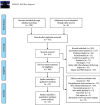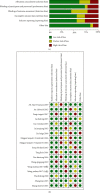Effects of Vitamin D on Respiratory Function and Immune Status for Patients with Chronic Obstructive Pulmonary Disease (COPD): A Systematic Review and Meta-Analysis
- PMID: 35313462
- PMCID: PMC8934228
- DOI: 10.1155/2022/2910782
Effects of Vitamin D on Respiratory Function and Immune Status for Patients with Chronic Obstructive Pulmonary Disease (COPD): A Systematic Review and Meta-Analysis
Retraction in
-
Retracted: Effects of Vitamin D on Respiratory Function and Immune Status for Patients with Chronic Obstructive Pulmonary Disease (COPD): A Systematic Review and Meta-Analysis.Comput Math Methods Med. 2023 Oct 18;2023:9831859. doi: 10.1155/2023/9831859. eCollection 2023. Comput Math Methods Med. 2023. PMID: 37885874 Free PMC article.
Abstract
Background: Many studies have demonstrated that vitamin D has clinical benefits when used to treat patients with chronic obstructive pulmonary disease (COPD). However, most of these studies have insufficient samples or inconsistent results. The aim of this meta-analysis was to evaluate the effects of vitamin D therapy in patients with COPD.
Methods: We performed a comprehensive retrieval in the following electronic databases: PubMed, Embase, Cochrane Library, China National Knowledge Infrastructure (CNKI), Wanfang Data, and Chinese Scientific Journals Database (VIP). Two trained reviewers identified relevant studies, extracted data information, and then assessed the methodical quality by the Cochrane risk of bias assessment tool, independently. Then, the meta-analyses were conducted by RevMan 5.4, binary variables were represented by risks ratio (RR), and continuous variables were represented by mean difference (MD) or standardized mean difference (SMD) to assess the efficacy of vitamin D therapy in patients with COPD. Then, publication bias assessment was conducted by funnel plot analysis. Finally, the quality of evidence was assessed by the GRADE system.
Results: A total of 15 articles involving 1598 participants were included in this study. The overall results showed a statistical significance of vitamin D therapy in patients with COPD which can significantly improve forced expiratory volume in 1 second (FEV1) (MD: 5.69, 95% CI: 5.01-6.38,P < 0.00001,I2 = 51%) and FEV1/FVC (SMD:0.49, 95% CI: 0.39-0.60,P < 0.00001,I2 = 84%); and serum 25 (OH)D (SMD:1.21, 95% CI:1.07-1.34,P < 0.00001,I2 = 98%) also increase CD3+ Tcells (MD: 6.67, 95% CI: 5.34-8.00,P < 0.00001,I2 = 78%) and CD4+ T cells (MD: 6.00, 95% CI: 5.01-7.00,P < 0.00001,I2 = 65%); and T lymphocyte CD4+/CD8+ ratio (MD: 0.41, 95% CI: 0.20-0.61,P = 0.0001,I2 = 95%) obviously decrease CD8+ Tcells(SMD: -0.83, 95% CI: -1.05- -0.06,P < 0.00001,I2 = 82%), the times of acute exacerbation (RR: 0.40, 95% CI: 0.28-0.59,P < 0.00001,I2 = 0%), and COPD assessment test (CAT) score (MD: -3.77, 95% CI: -5.86 - -1.68,P = 0.0004,I2 = 79%).
Conclusions: Our analysis indicated that vitamin D used in patients with COPD could improve the lung function (FEV1 and FEV1/FVC), the serum 25(OH)D, CD3+ T cells, CD4 + T cells, and T lymphocyte CD4+/CD8+ ratio and reduce CD8+ T cells, acute exacerbation, and CAT scores.
Copyright © 2022 Huan Yang et al.
Conflict of interest statement
The authors declare that they have no conflicts of interest.
Figures












Similar articles
-
The efficacy of vitamin D therapy for patients with COPD: a meta-analysis of randomized controlled trials.Ann Palliat Med. 2020 Mar;9(2):286-297. doi: 10.21037/apm.2020.02.26. Epub 2020 Mar 5. Ann Palliat Med. 2020. PMID: 32156131 Review.
-
Traditional Chinese medicine tonifying kidney therapy (Bu shen) for stable chronic obstructive pulmonary disease: Protocol for a systematic review and meta-analysis.Medicine (Baltimore). 2018 Dec;97(52):e13701. doi: 10.1097/MD.0000000000013701. Medicine (Baltimore). 2018. PMID: 30593141 Free PMC article.
-
Negligible effect of vitamin D supplementation on exacerbation in patients with chronic obstructive pulmonary disease: meta-analysis.Biochem Med (Zagreb). 2023 Oct 15;33(3):030703. doi: 10.11613/BM.2023.030703. Biochem Med (Zagreb). 2023. PMID: 37841773 Free PMC article.
-
Effects of external diaphragm pacing combined with conventional rehabilitation therapies in patients with chronic obstructive pulmonary disease: a systematic review and meta-analysis.Ther Adv Respir Dis. 2023 Jan-Dec;17:17534666231218086. doi: 10.1177/17534666231218086. Ther Adv Respir Dis. 2023. PMID: 38140896 Free PMC article.
-
Efficacy of acupuncture as adjunctive therapy for patients with acute exacerbation of chronic obstructive pulmonary disease: a systematic review and meta-analysis.Front Med (Lausanne). 2025 May 12;12:1513888. doi: 10.3389/fmed.2025.1513888. eCollection 2025. Front Med (Lausanne). 2025. PMID: 40421292 Free PMC article.
Cited by
-
Retracted: Effects of Vitamin D on Respiratory Function and Immune Status for Patients with Chronic Obstructive Pulmonary Disease (COPD): A Systematic Review and Meta-Analysis.Comput Math Methods Med. 2023 Oct 18;2023:9831859. doi: 10.1155/2023/9831859. eCollection 2023. Comput Math Methods Med. 2023. PMID: 37885874 Free PMC article.
-
Vitamin D for the management of chronic obstructive pulmonary disease.Cochrane Database Syst Rev. 2024 Sep 27;9(9):CD013284. doi: 10.1002/14651858.CD013284.pub2. Cochrane Database Syst Rev. 2024. PMID: 39329240
-
Clinical value of Vitamin-D combined with budesonide/formoterol and theophylline sodium glycinate sustained-release tablets in the treatment of chronic obstructive pulmonary disease patients.Pak J Med Sci. 2024 Aug;40(7):1391-1396. doi: 10.12669/pjms.40.7.9495. Pak J Med Sci. 2024. PMID: 39092061 Free PMC article.
-
The Effectiveness of Supplementation with Key Vitamins, Minerals, Antioxidants and Specific Nutritional Supplements in COPD-A Review.Nutrients. 2023 Jun 14;15(12):2741. doi: 10.3390/nu15122741. Nutrients. 2023. PMID: 37375645 Free PMC article. Review.
-
The Efficacy and Safety of Budesonide/Glycopyrronium/Formoterol in the Treatment of COPD in the Elderly.Contrast Media Mol Imaging. 2022 Aug 17;2022:8382295. doi: 10.1155/2022/8382295. eCollection 2022. Contrast Media Mol Imaging. 2022. Retraction in: Contrast Media Mol Imaging. 2023 Jul 19;2023:9819710. doi: 10.1155/2023/9819710. PMID: 36072633 Free PMC article. Retracted.
References
-
- Pauwels R. A., Buist A. S., Calverley P. M., Jenkins C. R., Hurd S. S., GOLD Scientific Committee Global strategy for the diagnosis, management, and prevention of chronic obstructive pulmonary disease. NHLBI/WHO global initiative for chronic obstructive lung disease (GOLD) workshop summary. American Journal of Respiratory and Critical Care Medicine . 2001;163(5):1256–1276. - PubMed
-
- Lopez A. D., Shibuya K., Rao C., et al. Chronic obstructive pulmonary disease: current burden and future projections. The European Respiratory Journal . 2006;27(2):397–412. - PubMed
Publication types
MeSH terms
Substances
LinkOut - more resources
Full Text Sources
Medical
Research Materials
Miscellaneous

